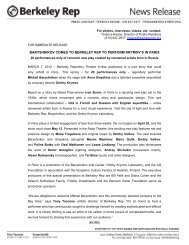the berkeley rep magazine - Berkeley Repertory Theatre
the berkeley rep magazine - Berkeley Repertory Theatre
the berkeley rep magazine - Berkeley Repertory Theatre
Create successful ePaper yourself
Turn your PDF publications into a flip-book with our unique Google optimized e-Paper software.
eport<br />
Before electricity, even before<br />
candlelight, <strong>the</strong> world premiere of The<br />
Iliad was performed under <strong>the</strong> brightest<br />
light available: <strong>the</strong> sun. In ancient Greece,<br />
plays were performed in <strong>the</strong> daytime<br />
for <strong>the</strong> simple reason that <strong>the</strong> audience<br />
couldn’t see at night. Forget about<br />
spotlights, colored gels, or mood lighting:<br />
ei<strong>the</strong>r you could see or you couldn’t.<br />
And that’s how it remained for<br />
hundreds of years. Although o<strong>the</strong>r<br />
advances (candles, oil lamps, and gas<br />
lamps) eventually allowed <strong>the</strong>atres to<br />
perform indoors and at night, none of<br />
<strong>the</strong>se devices could do more than make<br />
<strong>the</strong> stage visible.<br />
Until limelight. In <strong>the</strong> 1800s, a<br />
British scientist named Sir Goldsworthy<br />
Gurney discovered a way to create a<br />
sharp, focused light by burning quicklime<br />
with an oxyhydrogen flame. For<br />
<strong>the</strong> first time ever, <strong>the</strong>atres were able to<br />
direct <strong>the</strong> audience’s eye by highlighting<br />
small areas of <strong>the</strong> stage. This was a huge<br />
breakthrough. All of a sudden, <strong>the</strong>atrical<br />
lighting overcame its inauspicious beginning<br />
as basic necessity and became a<br />
legitimate craft.<br />
In 1837, <strong>the</strong> Covent Garden <strong>Theatre</strong><br />
in London made history with <strong>the</strong> firstever<br />
use of limelight in a <strong>the</strong>atrical<br />
production. It was an instant hit.<br />
Limelight was 37 times brighter than<br />
<strong>the</strong> strongest oil lamp at <strong>the</strong> time, and<br />
unlike oil lamps, limelight didn’t fill <strong>the</strong><br />
<strong>the</strong>atre with smoke and soot. Electric<br />
arc lights were also developed around<br />
this time, but <strong>the</strong>y were expensive,<br />
noisy, and gave off a slightly blueish<br />
light. Not that limelight was much<br />
better, color-wise; although <strong>the</strong> name<br />
comes from <strong>the</strong> quicklime, it also<br />
produced a slightly greenish light.<br />
Limelight—precursor to <strong>the</strong> modern<br />
spotlight—was a major advancement,<br />
but <strong>the</strong> technology still lacked any kind of<br />
subtlety. “I would love to have seen a play<br />
done in real limelight,” says Fred Geffken,<br />
<strong>Berkeley</strong> Rep’s master electrician, “but I<br />
also love <strong>the</strong> ability designers have now<br />
to mold <strong>the</strong> light to affect <strong>the</strong> audience’s<br />
emotions in each scene.” Fortunately,<br />
that ability wasn’t far off.<br />
In just a few decades, <strong>the</strong><br />
mainstream adoption of electricity<br />
10 · <strong>the</strong> <strong>berkeley</strong> <strong>rep</strong> <strong>magazine</strong> · 2012–13 · ISSUE 2<br />
Audrey Brisson, Patrycja Kujawska, and<br />
Éva Magyar in The Wild Bride (2011)<br />
changed everything once again. For<br />
<strong>the</strong> last hundred years, electric-lighting<br />
technology has accelerated at an<br />
amazing pace. We’ve gained <strong>the</strong> ability<br />
not just to light <strong>the</strong> room and direct<br />
<strong>the</strong> eye, but also to color, soften, excite,<br />
and amaze.<br />
At <strong>Berkeley</strong> Rep, it takes a team of<br />
four full-time electricians just to manage<br />
<strong>the</strong> lighting instruments. They hang, focus,<br />
<strong>rep</strong>air, and run <strong>the</strong> lights for each of<br />
our productions every season, all while<br />
keeping up with <strong>the</strong> latest innovations<br />
in <strong>the</strong>atrical lighting.<br />
The tools we use today are quickly<br />
being <strong>rep</strong>laced by even more exciting<br />
technologies, so we asked our electrics<br />
department—Fred Geffken, Christine<br />
Cochran, Kenneth Coté, and Anthony<br />
Jannuzzi—to speculate on <strong>the</strong> most<br />
promising developments on <strong>the</strong> horizon<br />
for <strong>the</strong>atrical lighting. The consensus<br />
was immediate: led lighting.<br />
“Recently, with <strong>the</strong> push for more<br />
energy-efficient lamps by <strong>the</strong> government,<br />
<strong>the</strong> led industry has improved<br />
<strong>the</strong> quality, intensity, and variety of<br />
leds,” Fred explains. “One of <strong>the</strong><br />
advantages is <strong>the</strong> ability for one light<br />
to produce multiple colors. This allows<br />
designers <strong>the</strong> ability to adjust <strong>the</strong> color<br />
at a moment’s notice to better match<br />
<strong>the</strong> mood of <strong>the</strong> play.”<br />
Although color mixing has been<br />
around for a while, leds are more<br />
energy-efficient and quieter than most<br />
existing options. Plus, <strong>the</strong>y’re brighter:<br />
“The intensity and vibrancy surpasses<br />
what conventional lights can do. Last<br />
season, we used color-mixing led lights<br />
in Emotional Creature, which made <strong>the</strong><br />
courtesy of kevinberne.com<br />
color really pop.” And keep an eye out<br />
for <strong>the</strong> return of <strong>the</strong> leds this season.<br />
Fred says we’ll see <strong>the</strong>m again when The<br />
Wild Bride returns.<br />
Interestingly, <strong>the</strong> exceptional<br />
smoothness and brightness of leds is<br />
actually its greatest weakness, at least<br />
if you’re a lighting designer. “One of <strong>the</strong><br />
problems with leds is that <strong>the</strong> color just<br />
doesn’t match <strong>the</strong> look of conventional<br />
lights, especially as <strong>the</strong>y dim,” Fred<br />
notes. “Ever notice when a lamp dims<br />
that <strong>the</strong> color shifts to red? Manufacturers<br />
are now making led fixtures that<br />
<strong>rep</strong>licate that color shift so <strong>the</strong>y can be<br />
added to a show alongside conventional<br />
lights without looking out of place.”<br />
So our new technology is actually<br />
mimicking older technology? It seems<br />
counterintuitive, but Fred explains: “In<br />
<strong>the</strong>atre, we’re always trying to <strong>rep</strong>licate<br />
<strong>the</strong> feeling of light in a certain place—<br />
your dining room, bedroom, or hotel<br />
room, say—or a quality of light like<br />
candlelight, gaslight, limelight, or firelight.”<br />
Because leds aren’t yet <strong>the</strong> norm,<br />
for <strong>the</strong> sake of <strong>the</strong>atrical verisimilitude,<br />
<strong>the</strong>y’re stuck <strong>rep</strong>licating <strong>the</strong> old styles.<br />
But Fred takes a philosophical approach.<br />
“It will be interesting to see, years from<br />
now, as fluorescent, led, or <strong>the</strong> next<br />
breakthrough in lighting technology<br />
takes hold in our lives…one day, we’ll<br />
be trying to <strong>rep</strong>licate <strong>the</strong> feeling of that<br />
lighting instead.”<br />
From sunlight to candles, limelight<br />
to leds, <strong>the</strong>atrical lighting is now coming<br />
full circle, using <strong>the</strong> latest technology<br />
to convince <strong>the</strong> viewer <strong>the</strong>y’re in<br />
Victorian England, <strong>the</strong> Industrial Revolution,<br />
or even ancient Greece.
















